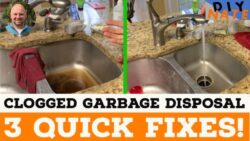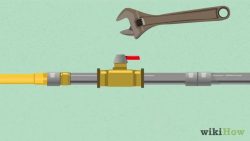In the unfortunate event that an item is accidentally flushed down a toilet, it can cause panic and frustration. However, the retrieval of such an object can be accomplished with the right techniques. This article provides practical advice on how to successfully retrieve an item from a flushed toilet, offering various methods that can be utilized depending on the circumstances. By following these step-by-step instructions, you will learn how to safely recover items and avoid potential plumbing mishaps.
Check for immediate solutions
When you find that an item has been accidentally flushed down the toilet, it’s important to act quickly to prevent any further damage. Here are some immediate solutions you can try before calling a professional plumber.
Stop the water flow
The first step is to stop the water flow to prevent any potential flooding. Locate the shut-off valve behind or beside the toilet and turn it off by twisting it clockwise. This will stop water from entering the toilet bowl and give you time to assess the situation.
Put on gloves
Before attempting any methods to retrieve the flushed item, it’s essential to protect your hands. Put on a pair of gloves to avoid any direct contact with the dirty water or any potential sharp objects that may be in the toilet.
Use a plunger
A plunger can be a useful tool to dislodge the flushed item and unclog the toilet. Ensure that the plunger is completely submerged in water and then create a firm seal around the drain opening. Push and pull the plunger in a steady motion to create pressure and dislodge the item. Repeat this process several times until the water starts to drain properly.
Try a drain snake
If the plunger fails to retrieve the item, you can try using a drain snake. Insert the snake into the toilet drain and slowly push it further until you feel resistance. Rotate the snake clockwise while applying gentle pressure to break up any potential blockages. Once you have reached the obstruction, carefully pull the snake out, and the item may come with it.
Use a wet/dry vacuum
In some cases, a wet/dry vacuum can be used to suction out the water and possibly retrieve the flushed item. Make sure the vacuum is appropriate for wet use and follow the manufacturer’s instructions. Place the vacuum hose into the toilet bowl and create a tight seal. Turn on the vacuum and allow it to suck out the water, checking periodically if the item has been retrieved.
Call a professional plumber
If the immediate solutions fail to retrieve the flushed item, it’s time to call a professional plumber. They have the expertise and specialized tools to effectively address the issue. Here are the steps to follow when contacting a plumber.
Evaluate the situation
Take note of the symptoms and details of the problem. Explain to the plumber what happened and any immediate actions you have taken. This will help them understand the urgency and provide appropriate advice.
Contact a reliable plumber
Do some research to find a reputable and reliable plumber in your area. Ask for recommendations from friends or family, or search for local plumbers online. Look for plumbers who are licensed, insured, and have positive reviews from previous customers.
Explain the problem
When contacting the plumber, clearly explain the issue you are facing with the flushed item. Provide as much detail as possible, including the size and type of the flushed object. The more information you provide, the better equipped the plumber will be to handle the situation.
Schedule an appointment
Once you have found a suitable plumber, schedule an appointment at a convenient time. Depending on the severity of the problem, they may be able to come immediately or provide a specific time slot. Follow their instructions regarding any preparations you need to make before their arrival.
Follow their instructions
When the plumber arrives, listen carefully to their instructions and follow them accordingly. They may need access to certain areas, require assistance, or need you to provide additional information. By cooperating fully, you can maximize the chances of successfully retrieving the flushed item.
Use basic household items
If you prefer to explore DIY options further before seeking professional help, here are some basic household items you can utilize to retrieve the flushed item.
Create a makeshift tool
Fashioning a makeshift tool from common household items can sometimes help retrieve the flushed item. For example, you could use a long, sturdy stick with adhesive tape attached to the end. Lower the stick into the toilet bowl and maneuver it carefully to attach the tape to the item. Slowly pull up the stick, hopefully bringing the item with it.
Use a wire hanger
Bend a wire hanger into a long hook shape. Insert the hook end into the toilet drain and gently maneuver it to catch onto the flushed item. Once hooked, slowly pull up the hanger, making sure the item remains secure until retrieved from the toilet bowl.
Try a plastic bottle
Cut the bottom off a plastic bottle and squeeze the sides toward the center, creating a narrow opening at the top. Insert the narrowed opening into the toilet drain and push it down, attempting to trap the flushed item within the bottle. Carefully remove the bottle, ensuring the object remains inside.
Make a vacuum with a plastic bag
Place a plastic bag over your hand, ensuring a secure fit. Lower your covered hand into the toilet bowl and maneuver it to enclose the flushed item. Once you have a secure grip, slowly and carefully withdraw your hand and the item from the toilet.
Disassemble the toilet
If other methods have failed, disassembling the toilet may be necessary to retrieve the flushed item. This requires a little more expertise and precaution, so if you’re uncomfortable with this approach, it’s best to seek professional help. Here are the steps to disassemble a toilet safely.
Turn off the water supply
Locate the shut-off valve behind or beside the toilet and twist it clockwise to turn off the water supply. This will prevent any water from refilling the toilet bowl when it is disassembled.
Drain the toilet
Flush the toilet once to drain as much water as possible from the tank and bowl. Use a sponge or towel to soak up any remaining water left in the bowl. This will make the disassembly process cleaner and more manageable.
Remove the toilet tank
Unscrew the bolts that secure the tank to the bowl using an adjustable wrench or pliers. Carefully lift the tank away from the bowl and place it in a safe area where it won’t get damaged.
Inspect the trap
Look into the bottom of the toilet bowl where the trap is located. You may be able to spot the flushed item from this vantage point. If you can reach it with gloves on, remove the item carefully. If it is out of reach, consider using a small flexible tool, such as a wire or a coat hanger, to retrieve it.
Retrieve the flushed item
If the item is not visible or accessible from the trap, you may need to remove the entire toilet bowl from the floor to gain full access. This is a more involved process and should be undertaken with caution. If you are unsure or uncomfortable, it is best to consult a professional plumber.
Retrieve from the drain pipe
In some cases, the flushed item may have traveled further down the drain pipe, making it more challenging to retrieve. Here are the steps you can take to locate and retrieve the item from the drain pipe.
Locate the main house drain
The main house drain is typically located in the basement or an access point outside the house. Look for a cleanout plug, a large threaded cap, or a removable cover. This is where you can gain access to the main drain pipe.
Remove a cleanout plug
Using a wrench or pliers, carefully remove the cleanout plug from the main drain. Be prepared for any residual water or debris that may come out when you remove the plug. This will provide you with an entry point to the main drain pipe.
Insert a plumbing snake
Insert a plumber’s snake or auger into the main drain pipe through the cleanout plug opening. Rotate the snake clockwise and gradually push it further into the pipe. This will help break up any obstructions and potentially retrieve the flushed item.
Flush with water
After using the plumbing snake, flush the toilet to introduce a large volume of water into the drain pipe. This can help dislodge the item further and bring it closer to the cleanout plug opening.
Retrieve the object
If the flushed item is within reach, use a gloved hand or a tool to retrieve it from the cleanout plug opening. If it’s still out of reach, consult a professional plumber who can safely and effectively retrieve the item for you.
Consider using chemicals
Using chemicals to dissolve a flushed item should be a last resort and done with caution. If the item is non-organic, chemicals may not be effective, and they can potentially damage your plumbing system. If you decide to use chemicals, here are the steps to follow.
Use a drain cleaner
Choose a drain cleaner specifically designed for toilets and follow the manufacturer’s instructions carefully. Make sure to use gloves and eye protection while handling the chemicals.
Follow safety instructions
Chemicals can be hazardous, so it’s crucial to take safety precautions. Work in a well-ventilated area, keep the area clear of children and pets, and avoid mixing different chemicals.
Give it time to work
Allow the drain cleaner to sit in the toilet bowl for the recommended amount of time. This will give the chemicals a chance to dissolve the item and any associated blockages. Be patient and avoid flushing the toilet during this time.
Flush the toilet
After the designated waiting period, flush the toilet and observe if the item has been dislodged. If successful, retrieve the item from the toilet bowl.
Retrieve the item
If the drain cleaner does not dissolve the item or the blockage, it’s best to seek professional assistance. Plumbers have access to powerful drain-clearing tools that can safely remove the item without causing further damage.
Consult online resources
If you’re facing a flushed item situation and want to explore more do-it-yourself options, there are several online resources that can provide guidance and advice.
Search for DIY solutions
Look for websites, blogs, or articles that offer DIY solutions for retrieving flushed items from toilets. Many plumbing professionals and experienced homeowners share their tips and techniques for successful retrieval.
Look for step-by-step guides
Search for step-by-step guides that walk you through the process of disassembling toilets, using household items, or employing specific tools. These guides often provide detailed instructions, illustrations, and troubleshooting tips.
Join plumbing forums
Joining online plumbing forums or communities can be a helpful way to seek advice and connect with others who have faced similar situations. Engage in discussions, ask questions, and learn from the experiences of others.
Ask for advice and tips
If you’re unsure about a particular method or need clarification, don’t hesitate to ask for advice and tips from the online community. Experienced individuals can offer guidance or suggest alternate approaches that you may not have considered.
Prevent future incidents
While accidents happen, there are measures you can take to minimize the chances of an item being flushed down the toilet. By implementing preventive measures, you can potentially avoid future incidents and the need for extensive retrieval efforts.
Educate family members
Ensure that everyone in your household understands the importance of not flushing inappropriate items down the toilet. Educate them about the potential consequences and the proper use of the toilet.
Install a drain strainer
Consider installing a drain strainer or guard in your toilet. This simple device fits over the drain opening and prevents larger items from accidentally falling in. Regularly clean the strainer to maintain its effectiveness.
Keep small objects away
To avoid accidental drops, keep small objects such as toys, jewelry, or personal care items away from the toilet and bathroom area. Make sure children understand the importance of keeping small items out of reach.
Regular toilet maintenance
Perform regular maintenance on your toilet to keep it in good working condition. This includes checking for any signs of leaks, ensuring the water flow is smooth, and promptly addressing any plumbing issues. Regular maintenance can help identify potential problems before they escalate into larger issues.
Consider professional assistance
In certain situations, it’s best to seek professional assistance to handle a flushed item scenario. Water damage restoration companies specialize in managing water-related emergencies and can guide you through the entire process.
Contact a water damage restoration company
If your toilet has overflowed, resulted in extensive water damage, or has caused other related issues, it’s advisable to contact a water damage restoration company. These professionals have the expertise and equipment to mitigate the damage and restore your home to its pre-incident condition.
Discuss the situation
When contacting a water damage restoration company, describe the situation in detail. Explain the flushed item, any visible damage, and the affected areas of your home. They will assess the severity of the situation and recommend appropriate solutions.
Seek their advice and services
Water damage restoration companies can offer advice on retrieving the flushed item and guide you through the necessary steps to minimize further damage. They may also provide services such as water extraction, drying, and restoration if needed.
Finding yourself in a situation where an item has been flushed down the toilet can be stressful, but there are multiple solutions available to retrieve the item. Begin by trying immediate solutions like stopping the water flow, using a plunger or drain snake, and using basic household items. If these methods aren’t successful, calling a professional plumber or considering disassembling the toilet may be necessary. You can also try retrieving the item from the drain pipe or use chemicals as a last resort. Don’t hesitate to consult online resources, seek advice, and take preventive measures to minimize the chances of a similar incident in the future. Remember, if the situation becomes too complex or if extensive water damage occurs, it’s best to contact a water damage restoration company for professional assistance.




